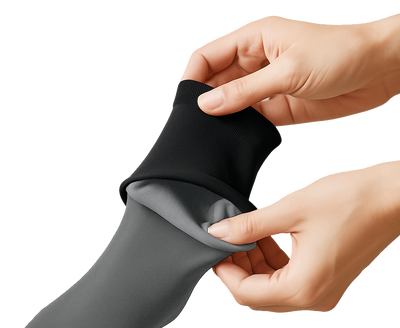Compression socks - The right level of compression for you

Compression levels commonly available
10 - 15 mmHg – Mild Compression
10 - 20 mmHg – Medium Compression
15 - 20 mmHg – Medium Compression
20 - 30 mmHg – Firm Compression
30 - 40 mmHg – Extra Firm
40 - 50 mmHg – RX
You will find six different compression levels readily available. A higher compression level does not mean greater effectiveness for you. Depending on your needs – support during sports activities, prevention of the venous problems or treatment of severe venous problems symptoms – you will have to consider the different level of compression that is the best for you.

Mild Compression
A compression level of 10-15 mmHg is very light and can be bought over the counter. This level of compression is beneficial for almost everyone, so there is no special restriction on who should use this type of compression stockings. Some of the benefits that mild compression provides are:
- Prevents leg fatigue and relieves pain caused by long hours of sitting or standing
- Helps relieve minor edema & swelling of ankles, feet, and legs
- During pregnancy, especially in the initial phases, prevents varicose veins and improves blood circulation in the legs
- Make your legs feel more energized while being physically active
Mild/Medium Compression
The 10-20 mmHg compression level is the most popular for its widespread use for people with minor swelling and tired, achy feet. If you play sports regularly, have a job that requires standing all day, or often travel long distances, you should consider wearing this level of compression to help your legs stay energized and keep the blood flowing at peak performance. Benefits and uses of mild/medium compression are:
- It helps relieve minor to moderate edema & swelling
- Helps reduce the risk of DVT or Deep Vein Thrombosis
- During pregnancy, it prevents venous insufficiency, varicose veins and improves blood circulation in the legs
- Athletes, or people who train regularly, prefer a medium level of compression.
Medium Compression
A compression level of 15-20 mmHg also falls into the category of widely spread use and people with conditions as a form of medical treatment. If you do sports regularly, have a sedentary job, or often travel long distances, you should consider wearing this level of compression to help your legs stay energized and keep the blood flowing right.
Firm Compression
This level of compression is the lowest of levels that fall into the category of medical-grade garments. Although they are labeled as medical-grade class I garments, you can still get one of these without a prescription. However, choosing compression socks as therapy should not be done without discussing it with your doctor or healthcare professional. Firm or moderate compression socks bring the following benefit:
- Helps relieve moderate to severe edema & swelling of feet, legs, and ankles
- Slow the progression of varicose veins and DVT
- Helps with active ulcers and manifestations of post-thrombotic syndrome (PTS)
- Helps prevent orthostatic hypotension (sudden dizziness and fall in blood pressure when standing up)
- Helps relieve superficial thrombophlebitis

Extra Firm Compression
Extra firm compression is a class II medical grade. Your doctor may recommend this level of compression to treat symptoms that classify as severe. Extra firm compression provides the following benefits:
- Helps treatment of severe edema and lymphedema
- Prevents the reappearance of varicose veins in a post-surgical and post-sclerotherapy treatment
- Reduces symptoms of Orthostatic Hypotension and Postural Hypotension
- Helps treatment of Deep Vein Thrombosis
- Treatment of venous ulcers and manifestations of Post-Thrombotic Syndrome (PTS)
Individuals experiencing various venous problems should consider wearing extra firm compression stockings. Conditions like Deep Vein Thrombosis, Chronic Venous Insufficiency, and severe lymphedema are the most common cases when wearing extra firm compression socks is strongly recommended.
RX
The 40-50 mmHg is the highest compression level, and buying compression socks with this compression level is an absolute no without a thorough consultation with your doctor. These stockings fall under the category of medical-grade class III. Class III means that they are typically used to treat severe varicose veins, post-thrombotic syndrome, chronic venous insufficiency, forms of severe lymphedema, or in conjunction with the management of open venous ulcers.
When deciding on the size of the compression socks, you should measure the proportion of your legs before the swelling occurs. If you take measurements while the edema is most severe, your legs will appear bigger, causing you to choose a larger size that won’t be as effective. It is also a practice to revise the adequacy of your stockings every six months, primarily if you use them to treat a medical condition. Support hose becomes looser over time due to the natural wearing process, so they will lose effectiveness if you don’t take proper care of them.
It is also a practice to revise the adequacy of your stockings every six months, especially if you use them to treat a medical condition. Stockings get looser over time due to washing and the natural wear-off process, so they can further lose their effectiveness if you don’t take proper care of them.
To sum up – if you are looking for everyday support and more energy for your legs, go with the mild or mild/moderate compression; if you suffer venous conditions, advise your healthcare specialist & occasionally revise what is best for you.
Skineez® Skin-Reparative is the only medical-grade compression brand clinically proven to protect your skin. Skineez® makes compression garments with FDA-Cleared, Skin-Reparative® microencapsulation technology and ingredients that protect your skin and make the fabric incredibly soft and easy to put on.
Skineez® offers stockings of compression levels ranging from mild (10-15 mmHg) to extra firm (30-40 mmHg),
CONSULT YOUR DOCTOR
Nowadays, compression socks have spread their use from strictly being a medical treatment for poor circulation and varicose veins to being widely used amongst athletes and workers, there are more types and compression levels than ever before.
Consult your doctor before using compression socks. Your doctor will recommend the correct compression level for your condition or medical treatment. This guide gives you a general knowledge of which compression level is suitable for which type of problem.
The measure used to denote the compression level is mmHg, and it should be easily visible on every compression product. MmHg stands for millimeters of mercury, and it shows the level of pressure or compression that socks provide. Millimeters of mercury is also the same measure used to measure blood pressure.
Compression stockings apply 100% of their strength at the ankle, about 70% power at the calf, and 50% strength at the top. Most of the time, compression is applied gradually. This graduation varies depending on the length of the stocking and the manufacturer.






